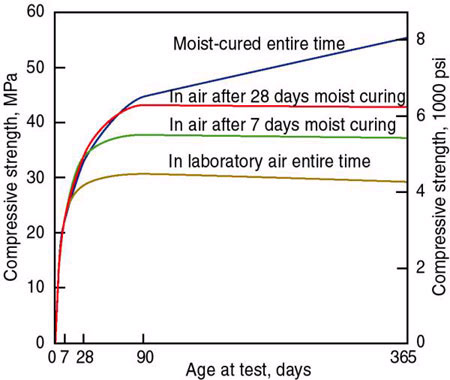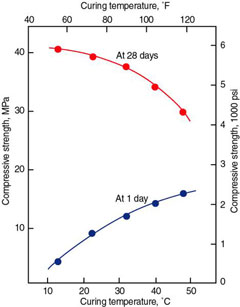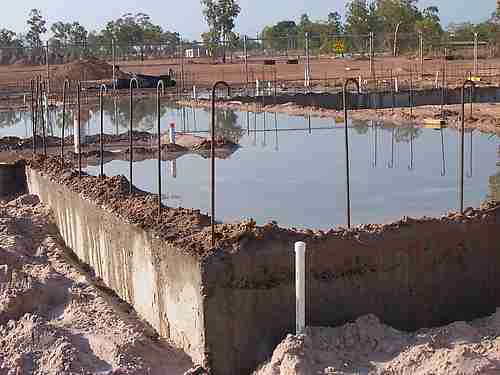|
| |
By Jerzy Z. Zemajtis, Ph.D., PE (WA):
Curing plays an important role on strength development and durability
of concrete. Curing takes place immediately after concrete placing and
finishing, and involves maintenance of desired moisture and temperature
conditions, both at depth and near the surface, for extended periods of
time. Properly cured concrete has an adequate amount of moisture for
continued hydration and development of strength, volume stability,
resistance to freezing and thawing, and abrasion and scaling resistance.
The length of adequate curing time is dependent on the following factors:
- Mixture proportions
- Specified
strength
- Size and shape of concrete member
- Ambient weather conditions
- Future
exposure conditions
Slabs on ground (e.g. pavements, sidewalks,
parking lots, driveways, floors, canal linings) and structural concrete (e.g.
bridge decks, piers, columns, beams, slabs, small footings, cast-in-place walls,
retaining walls) require a minimum curing period of seven days for ambient
temperatures above 40 degrees Fahrenheit1.
American Concrete Institute (ACI) Committee 301
recommends a minimum curing period corresponding to concrete attaining 70
percent of the specified compressive strength2.
The often specified seven-day curing commonly corresponds to approximately 70
percent of the specified compressive strengths. The 70 percent strength level
can be reached sooner when concrete cures at higher temperatures or when certain
cement/admixture combinations are used. Similarly, longer time may be needed for
different material combinations and/or lower curing temperatures. For this
reason, ACI Committee 308 recommends the following minimum curing periods3:
- ASTM C 150 Type I cement seven days
- ASTM C 150
Type II cement ten days
- ASTM C 150
Type III cement three days
- ASTM C 150
Type IV or V cement 14 days
- ASTM C 595,
C 845, C 1157 cements variable
Effect of curing duration on compressive
strength development is presented in Figure 1.

Figure 1. Moist Curing Time
and Compressive Strength Gain
Higher curing temperatures promote an early
strength gain in concrete but may decrease its 28-day strength. Effect of curing
temperature on compressive strength development is presented in Figure 2.

Figure 2. Effect of Curing
Temperature on Compressive Strength
There are three main functions of curing:
1) Maintaining mixing water in concrete during the early hardening
process
Ponding and immersion
Ponding is typically used to cure flat surfaces on smaller jobs. Care should be
taken to maintain curing water temperature at not more than 20 degrees
Fahrenheit cooler than the concrete to prevent cracking due to thermal
stresses. Immersion is mainly used in the laboratory for curing concrete test
specimens.
Spraying and fogging
Spraying and fogging are used when the ambient temperatures are well above
freezing and the humidity is low. Fogging can minimize plastic shrinkage
cracking until the concrete attains final set.
Saturated wet coverings
Wet coverings saturated with water should be used after concrete has hardened
enough to prevent surface damage. They should be kept constantly wet.
Left in Place Forms
Left in place forms usually provide satisfactory protection against moisture
loss for formed concrete surfaces. The forms are usually left in place as long
as the construction schedule allows. If the forms are made of wood, they should
be kept moist, especially during hot, dry weather.
Continued down....
Articles:
-
Marble or Granite
countertops which is better
-
Granite is a good choice for flooring tiles
-
What is Kerb stones ?
-
A house with 30,000 red bull
bottles
-
Roofing Parts and Terminology
-
Guidelines for Building a Boundary Wall
-
Various Ways To Use Granite Tiles
-
Top 10 Things to Consider in a New House Plan
-
Interior design: Decorative
panels from Sugarcane
-
New Home or Resale? Here are 5 Things to Consider
-
Space Saving Ideas for Your Small Flat
-
How To Choose Your Flooring Materials
-
Construction: What is
GRP or fibreglass ?
-
How
to check water leakage in your Plumbing lines
-
Interior design : What is
MDF-Medium Density Fiberboard. ?
-
Construction: What is epoxy
based paint?
-
Guidelines and tips: To find a reliable Builder or
Contractor
-
Guidelines & tips
before you start house construction
-
What is top-up housing loan ?
-
Home improvement tips:
Wallpaper for interiors
-
Benefits of rainwater
harvesting in homes
-
Tips & guidelines: Electricity Saving at home
-
Coming Up With Landscaping Ideas
-
How to set out a building on site
-
Interior design: The Rebirth of Wallpaper
-
What
is
Green Building ?
-
What is Domestic biogas plant ?
-
Why home insurance is very important in India?
-
How To Install a Home Wind Turbine
to get energy
-
How to Install Electric Wiring
-
Significance of Home Plumbing
-
Should I buy or rent? A simple calculation
-
Easy Landscaping Tips for Beginners
-
Construction technique:
Rapidwall technology
-
Buying a flat? Don't get carried away by the sample
-
30-storey hotel built in just 15
days
-
Is it worth buying an old
house
-
House plans, home plans, plans, residential plans
-
House Loans, home loans, where to get housing loan
-
How do loans work, the basic concepts of loans
-
Construction Tips, construction guide lines,
-
house rental tips, rental tips, renting properties
-
Real Estate
-
Flooring
-
What is Reverse Mortgage
-
Guidelines to purchase residential properties
-
Lotus-shaped 91 feet prayer hall in kerala
-
What is Interior Design, interior desings, resources
-
Interior Design Colleges
-
Interior Design- Bed Rooms
-
Interior Design- Bath Rooms
-
Kitchen Designs, kitchens
-
Modern Architectural Design Softwares
-
Landscaping Designs landscape architectures
-
-
|
|
2) Reducing the loss of mixing water
from the surface of the concrete
Covering concrete with impervious paper
or plastic sheets
Impervious paper and plastic sheets can be applied on thoroughly wetted
concrete. The concrete surface should be hard enough to prevent surface damage
from placement activities.
Applying membrane-forming curing compounds
Membrane-forming curing compounds are used to retard or reduce evaporation of
moisture from concrete. They can be clear or translucent and white pigmented.
White-pigmented compounds are recommended for hot and sunny weather conditions
to reflect solar radiation. Curing compounds should be applied immediately after
final finishing. Curing compound shall comply with ASTM C3094 or ASTM
C13155.
3) Accelerating strength gain using heat
and additional moisture
Live steam
Live steam at atmospheric pressure and high-pressure steam in autoclaves are the
two methods of steam curing. Steam temperature for live steam at atmospheric
pressure should be kept at about 140 degrees Fahrenheit or less until the
desired concrete strength is achieved.
Heating coils
Heating coils are usually used as embedded elements near the surface of concrete
elements. Their purpose is to protect concrete from freezing during cold weather
concreting.
Electrical heated forms or pads
Electrical heated forms or pads are primarily used by precast concrete
producers.
Concrete blankets
Concrete insulation blankets are used to cover and insulate concrete surfaces
subjected to freezing temperatures during the curing period. The concrete should
be hard enough to prevent surface damage when covering with concrete blankets.
Other forms of curing include internal moist
curing with lightweight aggregates or absorbent polymer particles. For mass
concrete elements (usually thicker than 3 feet), a thermal control plan is
usually developed to help control thermal stresses. Additional information can
be found in ACI Committee 308 report Guide to Curing Concrete3.
For specialty concretes, it is recommended to refer to other ACI reports as
follows:
- Refractory concrete ACI 547.1R
- Refractory
concrete ACI 547.1R
- Insulating
concrete ACI 523.1R
- Expansive
cement concrete ACI 223
-
Roller-compacted concrete ACI 207.5R
-
Architectural concrete ACI 303R
- Shotcrete
ACI 506.2
-
Fiber-reinforced concrete ACI 544.3R
- Vertical
slipform construction ACI 313
Curing in either cold or hot weather requires
additional attention. In cold weather, some of the procedures include heated
enclosures, evaporation reducers, curing compounds, and insulating blankets. The
temperature of fresh concrete shall be above 50 degrees Fahrenheit. The curing
period for cold weather concrete is longer than the standard period due to
reduced rate of strength gain. Compressive strength of concrete cured and
maintained at 50 degrees Fahrenheit is expected to gain strength half as quickly
as concrete cured at 73 degrees Fahrenheit. In hot weather, curing and
protection are critical due to rapid moisture loss from fresh concrete. The
curing actually starts before concrete is placed by wetting substrate surfaces
with water. Sunscreens, windscreens, fogging, and evaporation retardants can be
used for hot weather concrete placements. Since concrete strength gain in hot
weather is faster, curing period may be reduced. Additional information can be
found in ACI 306.1, Standard Specification for Cold Weather Concreting,
ACI 306R, Cold Weather Concreting, ACI 305.1, Specification for Hot
Weather Concreting, and ACI 305R, Hot Weather Concreting
Curing Concrete Test Specimens
Curing of concrete test specimens is usually
different from concrete placed during construction. American Society for Testing
and Materials (ASTM) has developed two standards for making and curing concrete
specimens. ASTM C1926 is intended for laboratory samples while ASTM
C317 is intended for field samples. Both documents provide
standardized requirements for making, curing, protecting, and transporting
concrete test specimens under field or laboratory conditions, respectively.
ASTM C192 provides procedures for evaluation of different mixtures in laboratory
conditions. It is usually used in the initial stage of the project, or for
research purposes.
ASTM C31 is used for acceptance testing and can also be used as a decision tool
for form or shoring removal. Depending on its intended purpose, the standard
defines two curing regimes: standard curing for acceptance testing and field
curing for form/shoring removal. Variation in standard curing of test specimens
can dramatically affect measured concrete properties. According to the National
Ready Mix Concrete Association8 (NRMCA), strength for concrete air
cured for one day followed by 27 days moist cured will be approximately 8
percent lower than for concrete moist cured for the entire period. The strength
reduction is 11 percent and 18 percent for concrete specimens initially cured in
air for three days and seven days, respectively. For the same air/moist curing
combinations, but 100 degrees Fahrenheit air curing temperature, the 28-day
strength will be approximately 11 percent, 22 percent, and 26 percent lower,
respectively.
References
S. Kosmatka et al,
Design and Control of Concrete Mixtures,
15th Edition,
EB001, PCA Engineering Bulletin EB 001, Portland Cement Association , Skokie, IL
2002
Specifications for Structural Concrete,
ACI 301 (www.concrete.org)
Guide to Curing Concrete, ACI 308R-01 (www.concrete.org)
ASTM C309,
Standard Specification
for Liquid Membrane-Forming Compounds for Curing Concrete (www.astm.org)
ASTM C1315, Standard Specification for
Liquid Membrane-Forming Compounds Having Special Properties for Curing and
Sealing Concrete (www.astm.org)
ASTM C192 / C192M, Standard Practice for Making and Curing Concrete Test
Specimens in the Laboratory (www.astm.org)
ASTM C31 / C31M, Standard Practice for
Making and Curing Concrete Test Specimens in the Field (www.astm.org)
For more information about curing,
click here.
( Courtesy:
America's Cement manufactures )
| |
|





